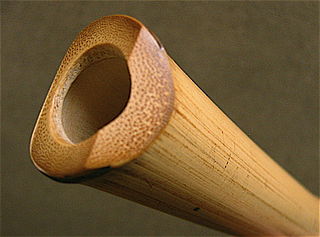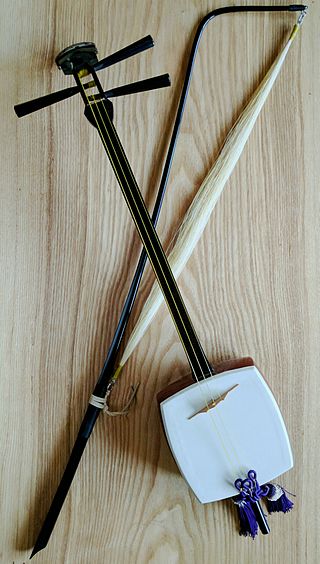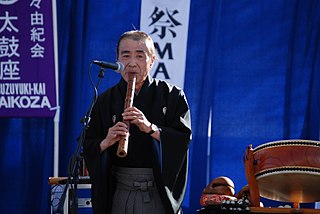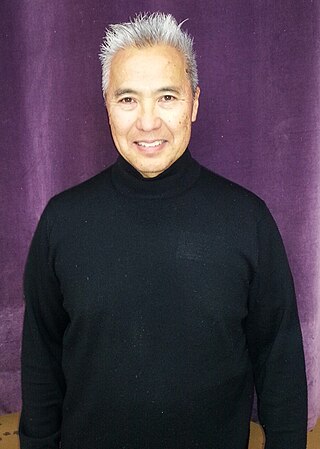
A shakuhachi is a Japanese longitudinal, end-blown flute that is made of bamboo. The bamboo end-blown flute now known as the shakuhachi was developed in Japan in the 16th century and is called the fuke shakuhachi (普化尺八). A bamboo flute known as the kodai shakuhachi or gagaku shakuhachi (雅楽尺八) was derived from the Chinese xiao in the Nara period and died out in the 10th century. After a long blank period, the hitoyogiri shakuhachi (一節切尺八) appeared in the 15th century, and then in the 16th century, the fuke shakuhachi was developed in Japan. The fuke shakuhachi flourished in the 18th century during the Edo period, and eventually the hitoyogiri shakuhachi also died out. The fuke shakuhachi developed in Japan is longer and thicker than the kodai shakuhachi and has one finger hole less. It is longer and thicker than hitoyogiri shakuhachi and is superior in volume, range, scale and tone quality. Today, since the shakuhachi generally refers only to fuke shakuhachi, the theory that the shakuhachi is an instrument unique to Japan is widely accepted.
Gagaku is a type of Japanese classical music that was historically used for imperial court music and dances. Gagaku was developed as court music of the Kyoto Imperial Palace, and its near-current form was established in the Heian period (794-1185) around the 10th century. Today, it is performed by the Board of Ceremonies in the Tokyo Imperial Palace.
Watazumi DosoRoshi was a master of the end-blown Japanese bamboo flute. He studied Rinzai Zen, attaining the title of rōshi.

The hotchiku, sometimes romanized as hocchiku or hochiku, is a Japanese aerophone, an end-blown bamboo flute, crafted from root sections of bamboo. The bamboo root is cleaned and sanded, resulting in a surface patterned with many small, circular knots where the roots formerly joined the stalk. The same part of the bamboo plant is also used to produce the shakuhachi but, unlike the shakuhachi, the hotchiku's inside (bore) and outside surfaces are left unlacquered, and an inlay is not used in the mouthpiece. The membranes at the nodes inside a hotchiku bore are generally left more intact than those of a shakuhachi, though older komuso shakuhachi also share this trait. Together, these characteristics make for a visibly and audibly raw and organic instrument. Hotchiku are sometimes referred to as jinashi nobekan, meaning "without ji [a paste made of clay and lacquer, used to smooth the bore on modern shakuhachi], one-piece"; hotchiku are not cut in two pieces for crafting or storage, unlike modern shakuhachi that are used as musical instruments.

The kokyū (胡弓) is a traditional Japanese string instrument, the only one played with a bow. A variant of the instrument also exists in Okinawa, called kūchō (胡弓) in Okinawan.
Atsuya Okuda is a Japanese-born master player and teacher jinashi shakuhachi, an unrefined bamboo flute. Prior to dedicating his efforts to the bamboo flute, he was a professional jazz trumpet player from approximately 1965 until 1985.
Frank Denyer is a composer. His music uses a combination of conventional instruments and new, unusual, and structurally modified instruments. Partly due to his studies of non-Western music, much of Denyer's music is microtonal.
Katsuya Yokoyama was a Japanese musician who played the shakuhachi, a traditional vertical bamboo flute.
The Nohkan is a high pitched, Japanese transverse bamboo flute, or fue. It is commonly used in traditional Imperial Noh and Kabuki theatre. The nohkan flute was created by Kan'ami and his son Zeami in the 15th century, during the time when the two were transforming the Noh theatre forms Dengaku and Sarugaku.
Hōzan Yamamoto was a Japanese shakuhachi player, composer and lecturer.

Masakazu Yoshizawa was a Japanese American flutist and musician, known for his mastery of the bamboo flute, specifically the shakuhachi. Yoshizawa also mastered several other traditional Japanese flutes, in addition to other Japanese and Western musical instruments. He was also considered a scholar of ancient and modern Japanese traditional music. Yoshizawa's work and music were featured in a number of major Hollywood studio films and soundtracks, including The Joy Luck Club and Memoirs of a Geisha.

Karaikudi Mani was an Indian mridangam player.
Riley Kelly Lee is an American-born Australian-based shakuhachi player and teacher. In 1980 he became the first non-Japanese person to attain the rank of Dai Shihan in the shakuhachi tradition. He is a recipient of two of the most revered lineages of shakuhachi playing, descending from the original Zen Buddhist "priests of nothingness" of the Edo period. His first teachers were Hoshida Ichizan II and Chikuho Sakai II. A later teacher was Katsuya Yokoyama.

Kenny Endo is an American musician and taiko master. He is the leader of several taiko ensembles and regularly tours, performing traditional and contemporary taiko music. Endo is also the first non-Japanese national to receive a natori in the field of hogaku hayashi, Japanese classical drumming. Today Endo composes his own music and plays taiko professionally as a solo artist, with his ensembles, and in collaboration with other artists.
James Nyoraku Schlefer, born 1956 in Brooklyn, New York, is a performer and teacher and composer of shakuhachi in New York City. He received the Dai-Shi-Han certificate in 2001, one of only a handful of non-Japanese to receive this high-level award. In 2008, he received his second Shi-Han certificate from Mujuan Dojo, in Kyoto. In Japan, Schlefer has worked with Reibo Aoki, Katsuya Yokoyama, Yoshio Kurahashi, Yoshinobu Taniguchi, and Kifu Mitsuhashi. His first teacher was Ronnie Nyogetsu Seldin. He holds a master's degree in Western flute and musicology from Queens College and currently teaches shakuhachi class at Columbia University and music history courses at the City University of New York. He has performed at Carnegie Hall, Lincoln Center, the Kennedy Center, Tanglewood, BAM, the Metropolitan Museum, at colleges and universities throughout the US and has toured in Japan, Indonesia, Brazil and counties in Europe. Schlefer has four solo recordings, Wind Heart(which travelled 120,000,000 miles aboard the Space Station MIR) Solstice Spirit (1998), Flare Up (2002), and In The Moment (2008). His music has been featured on NPR's All Things Considered. Schlefer's latest recording Spring Sounds, Spring Seas was released in June 2012 and features his original music for shakuhachi and orchestra.
Rodrigo Rodríguez is a Spanish shakuhachi player.
Due to the effects of westernization, western music has influenced many musical cultures around the world. Japan's unique music styles were impacted by this phenomenon prior to the Second World War. Japan's traditional melodic and instrumental music is now less popular than the emergent genres, such as J-Rock and J-Pop. The westernization of Japan has also included the increase of the English language and guitars in musical composition.
Masahiko Satoh is a Japanese jazz pianist, composer and arranger.
Minoru Muraoka was a Japanese shakuhachi player. He became well-known for using the shakuhachi to play jazz music, which was influential on popularizing the instrument in contemporary Japanese music.
Jonathan McCollum, Professor of Music at Washington College in Chestertown, Maryland, is an ethnomusicologist and performer on the Japanese shakuhachi, trombone, and bass trombone. He is the founding Chair of the Historical Ethnomusicology section of the Society for Ethnomusicology, and is known for his work on the music of Armenia and Japan.






